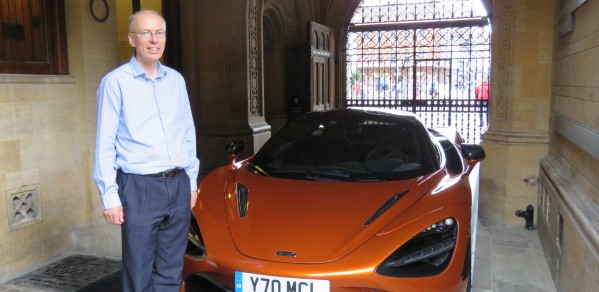
The latest McLaren supercar was displayed at Gonville & Caius college yesterday in honour of a professor whose research helped revolutionise suspension systems in motorsport.
I consider it an incredible honour to have the car here. What’s really nice is that McLaren has recognised an academic contribution – companies don’t always do that. Hopefully McLaren feel it is good to be associated with advanced academic work.
Professor Smith
The 720S, launched at the Geneva Motor Show in March and boasting a top speed of 217mph, is showcased within the Great Gate at Caius, allowing College members to admire its design close up and passers by to view it from Kings Parade.
The supercar, whose design was inspired by the “sleek yet brutally efficient” lines of the great white shark, has been brought to the College to mark the sixtieth birthday of Malcolm Smith, Professor in Control Engineering and a Fellow of Caius.
The College hosted a workshop run by the Department of Engineering to mark Professor Smith’s contribution to the field of Control, with presentations from academics from Japan, the United States and Germany, as well as the University of Cambridge.
The chance to display the McLaren is a particularly suitable birthday gift as the semi-active suspension system on the car has been designed using a theory developed by Professor Smith himself, together with his former PhD student Panos Brezas.
Research by the pair helped the car’s designers address the problem of finding the optimum balance between ride (the comfort of the car) and handling. Sensors relay the state of the road and an on-board computer analyses the information every millisecond to find the best possible setting for components called semi-adjustable dampers. A new algorithm designed by Prof Smith and Dr Brezas is the key new element in the 720S that permits optimal control at all times, no matter what the road conditions.
The car, which costs £210,000 for the basic model and £250,000 for the one at Caius, was tested by McLaren in a wide range of motoring conditions, ranging from Death Valley and the snows of Colorado and the Alps to a bumpy roundabout near Woking. The roundabout, though it sounds an unglamorous setting for a supercar, offered a perfect combination of demanding handling and an uneven road surface, permitting testing of the algorithm’s ability to find a balance between comfort and control.
As the 720S was delivered to Caius yesterday, Professor Smith said: “I consider it an incredible honour to have the car here. What’s really nice is that McLaren has recognised an academic contribution – companies don’t always do that. Hopefully McLaren feel it is good to be associated with advanced academic work.”
He modestly shrugged off his own contribution to the supercar, saying: “I am a control systems specialist and theorist. It is just another example of a control system.”
Other College members formed a queue to take photographs, with some even being lucky enough to sit in the driving seat – though no one was permitted to take the supercar out for a spin. Professor Smith did enjoy a trip as a passenger, however.
An earlier development by Professor Smith, another vehicle suspension device called an inerter, helped revolutionise Forumla 1 motorsport and is now widely used in the sport.

